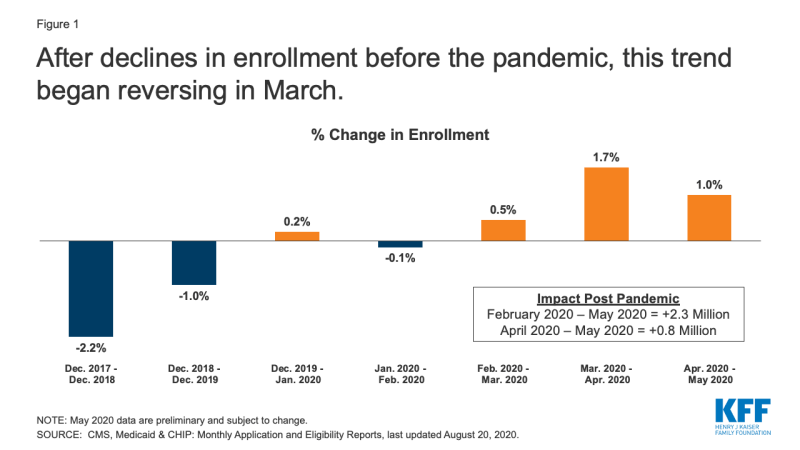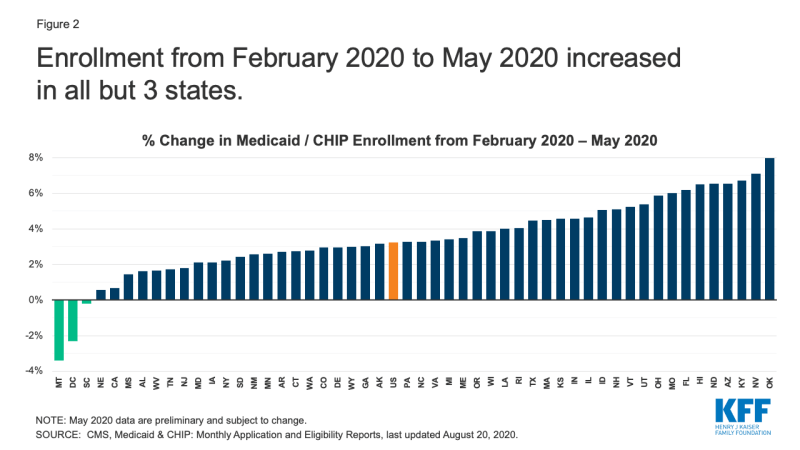This data note looks at national and state-by-state Medicaid and CHIP preliminary enrollment data through May 2020, as states were still in the early stages of experiencing the health and economic effects of the coronavirus pandemic. Data show that after declines in enrollment from December 2017 through December 2019, total enrollment grew to 73.5 million in May, an increase of 0.8 million from April 2020 (1%) and 2.3 million from February (3.2%), right before the pandemic. (Figure 1) These early data suggest that recent increases in enrollment may be reversing previous trends of flat or negative enrollment growth. These trends likely reflect changes in the economy (as more people experience income and job loss and become eligible and enroll in Medicaid coverage) and provisions in the Families First Coronavirus Response Act (FFCRA) that require states to ensure continuous coverage to current Medicaid enrollees to access a temporary increase in the Medicaid match rate. Because Medicaid enrollment may lag behind increases in unemployment, data for subsequent periods will likely show continued enrollment growth.
The information is based on Kaiser Family Foundation analysis of the Centers for Medicare and Medicaid Services (CMS) Performance Indicator Project Data. The preliminary data for May showing upward enrollment trends are consistent with early analysis of Medicaid managed care enrollment data for a subset of states through May 2020 that pointed to increased enrollment.
Medicaid enrollment was declining prior to the pandemic. Following the implementation of the Affordable Care Act (ACA) Medicaid expansion to low-income adults in 2014, there were large increases in Medicaid and CHIP enrollment across states that followed steady growth in coverage of children over the past decade. These increases reflected enrollment among newly eligible adults in states that implemented the expansion as well as enrollment among previously eligible adults and children due to enhanced outreach and enrollment efforts and updated enrollment procedures tied to the ACA. This trend began reversing when enrollment started to decline in 2018 and continued to decline in 2019. Total enrollment fell from 73.4 million in December 2017 to 71.1 million in December 2019, a decline of 2.3 million people or 3.1 percent. Month to month enrollment declines slowed, but continued until March 2020. The declines in enrollment, in part, reflected a robust economy, but experiences in some states suggested that they may have also reflected enrollment losses among people who were still eligible for coverage due challenges completing enrollment or renewal processes.
Recent data suggest that Medicaid enrollment may be increasing amid the coronavirus pandemic. Enrollment from February through May 2020 (the most recent time period available) increased by 2.3 million or 3.2%. Recent increases could reflect new enrollment related to changes in the economy and job loss, as well as eligibility and enrollment requirements included in the Families First Coronavirus Response Act (FFCRA). Under the FFCRA, to be eligible for enhanced federal Medicaid matching funds, states must ensure continuous coverage for those enrolled as of March 18, 2020 and cannot make eligibility and enrollment more restrictive than policies in place as of January 2020. Preliminary data show that since February (prior to the pandemic) all but three states experienced increases in enrollment. (Figure 2) For the same period (February to May) states reported larger increases in enrollment for adults (1.5 million or 4.3%) relative to kids (0.7 million or 2.0%). (Appendix Tables 2 and 3)
Enrollment will likely continue to grow as the pandemic continues to negatively impact the economy. Another KFF analysis suggests that job loss and loss of employer sponsored coverage will result in more people eligible for Medicaid, particularly in states that have adopted the Medicaid expansion in the Affordable Care Act (ACA). However, increases in Medicaid enrollment may lag being increases in unemployment. So, as unemployment continues to grow, more people will continue to become eligible and enroll in Medicaid, helping people who lose job-based insurance to maintain coverage but also putting increasing pressure on state budgets. Preliminary national data for the most recent month is lagged for about three months, but future data will provide more clear insight into how national and state-by-state Medicaid enrollment is responding to the pandemic.


